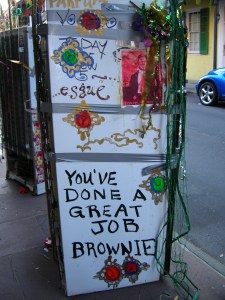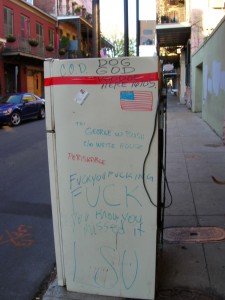
David Beriss
University of New Orleans
It would be hard to not notice that the tenth anniversary of hurricane Katrina is upon us here in New Orleans. I have been trying to think of ways that this blog might be used as a platform for thinking about the last decade. What is it that anthropology—specifically, the anthropology of food—might have to say about how things have turned out here? I am going to try to write a few short blog postings that can help answer that question. These are mostly personal reflections, but there is also some actual research behind some of my observations. I will try to indicate when that is the case.
Mostly, I want to evoke some of the scenes that have shaped the experience of the last decade in terms of food in New Orleans. I could start, for example, with the sublime meatball sandwich I had at the Italian Pie (a local chain) at the corner of Magazine and Joseph streets in mid-October 2005. Sublime largely because it was there and available in a city in which most of the restaurants were still closed. Or the stunningly good shrimp po’boy I ate at Crabby Jack’s soon after I returned, possibly in the company of my colleague Martha Ward. To this day, that post-exile shrimp po’boy stands out in my mind as the best po’boy ever. Eating in restaurants then was an opportunity to reconnect with friends and with strangers while getting a sense that the city was really coming back to life. But there was also a practical reason why people, even people who did not live in flooded neighborhoods, had to eat out in the beginning. There simply was not a lot of food available in stores (if the stores were open).
And whether or not your house flooded, in all likelihood, you did not have a refrigerator. In 2006, in an online discussion, someone posted a very theoretical query about refrigeration and technology. I was inspired to write a very short (not very theoretical) response that summed up our refrigeration issues. In thinking about the “Katrinaversary” (a word I did not make up), I remembered that note and dug it up. Given the importance of technology like refrigerators for making our contemporary food system possible, I think it is worth recalling what the failure of that technology meant back in 2005. Here is the note, more or less as originally posted, with a few additional thoughts:

Here in New Orleans, refrigerators became, after Katrina, the site for many reflections on identity, decay and waste. They stank and were teeming with maggots. Several weeks without power, it turns out, reveals that your refrigerator is not actually well sealed against bugs. It also reveals that things like meat eventually turn to liquid if left to their own devices, without refrigeration. Actually, many other things concerning the place of refrigeration in our lives were revealed that most of us would have been happier not knowing.
Anyhow, most people (and many restaurants) found it impossible to fully clean the refrigerators, so that even in the unflooded parts of the city, all last fall the streets were lined with hundreds of thousands of discarded refrigerators (I am not exaggerating — scale is important to this story), most of them duct-taped closed, in order to prevent the putrid contents from walking off. The mostly white exteriors proved to be an irresistible canvas for commentary about everything from FEMA and President Bush, to Saints owner Tom Benson (who had threatened to take the team from the city permanently), the mayor, and, of course, the general funkiness (not the good kind) of the fridges themselves. If you search on Google, you will find many collections of photos of these fridges available on the web. Here are a few links to some collections of pictures:
https://commons.wikimedia.org/wiki/Category:Fridges_damaged_by_Hurricane_Katrina
http://www.flickr.com/photos/84995794@N00/sets/1733550/
http://www.flickr.com/photos/unapologetic/sets/1092465/
One thing that is hard to express in writing is the overwhelming smell that hung over the city during most of the fall of 2005. We call it the Katrina smell and, if you were here, you recognize it immediately. I guess it is the smell of death and decay on a large scale. It is not a nice smell. It was accompanied by large numbers of what I am told are called “corpse flies” buzzing about the city and even inside your house (if you had one).
Those of us who have houses mostly have new refrigerators by now. Our relationship to those beautiful new machines has been transformed, I think. At least mine has. But that is another story.

Let me conclude with a sense of how that relationship has changed. Before 2005, I suspect I was like a lot of other Americans, using the fridge and freezer to store a lot of food, some of which we might not get around to using for quite a while. No more. In the last decade, we have become very much of a “just in time” family, keeping only enough food around for the week. There is too much danger of having to toss the entire contents of the fridge (and waste both food and money) to keep much more than that around. What we do have in terms of surplus, we are quick to share with our neighbors when the power goes out. The last time we had an extended power outage here (Hurricane Isaac, 2012, I believe), we had a series of dinners and parties with our neighbors over a few days in which we all tried to exhaust the contents of our refrigerators. Then we threw the rest out, unplugged the machines, and left the doors open. When the power eventually returned, the refrigerators mostly worked. And they were maggot free. Which is priceless.
1 Comment